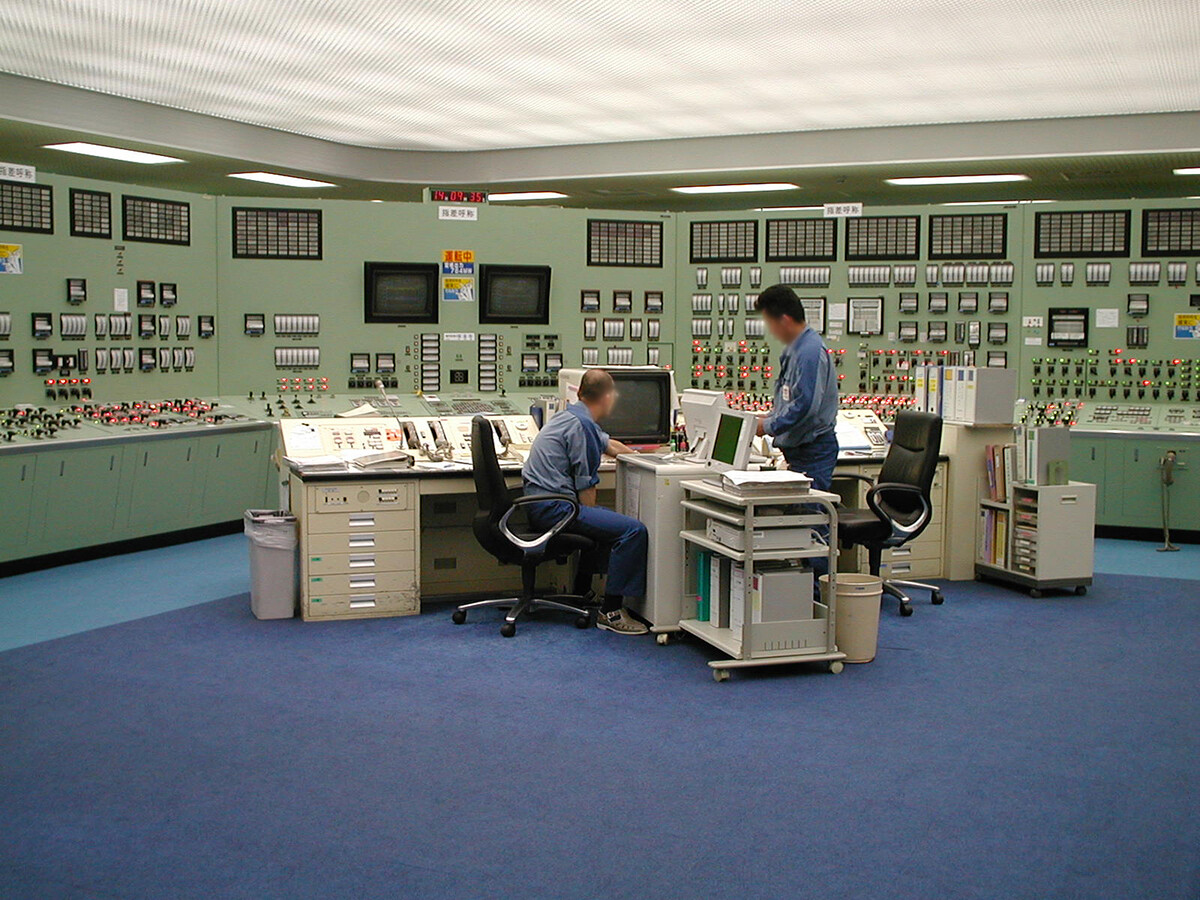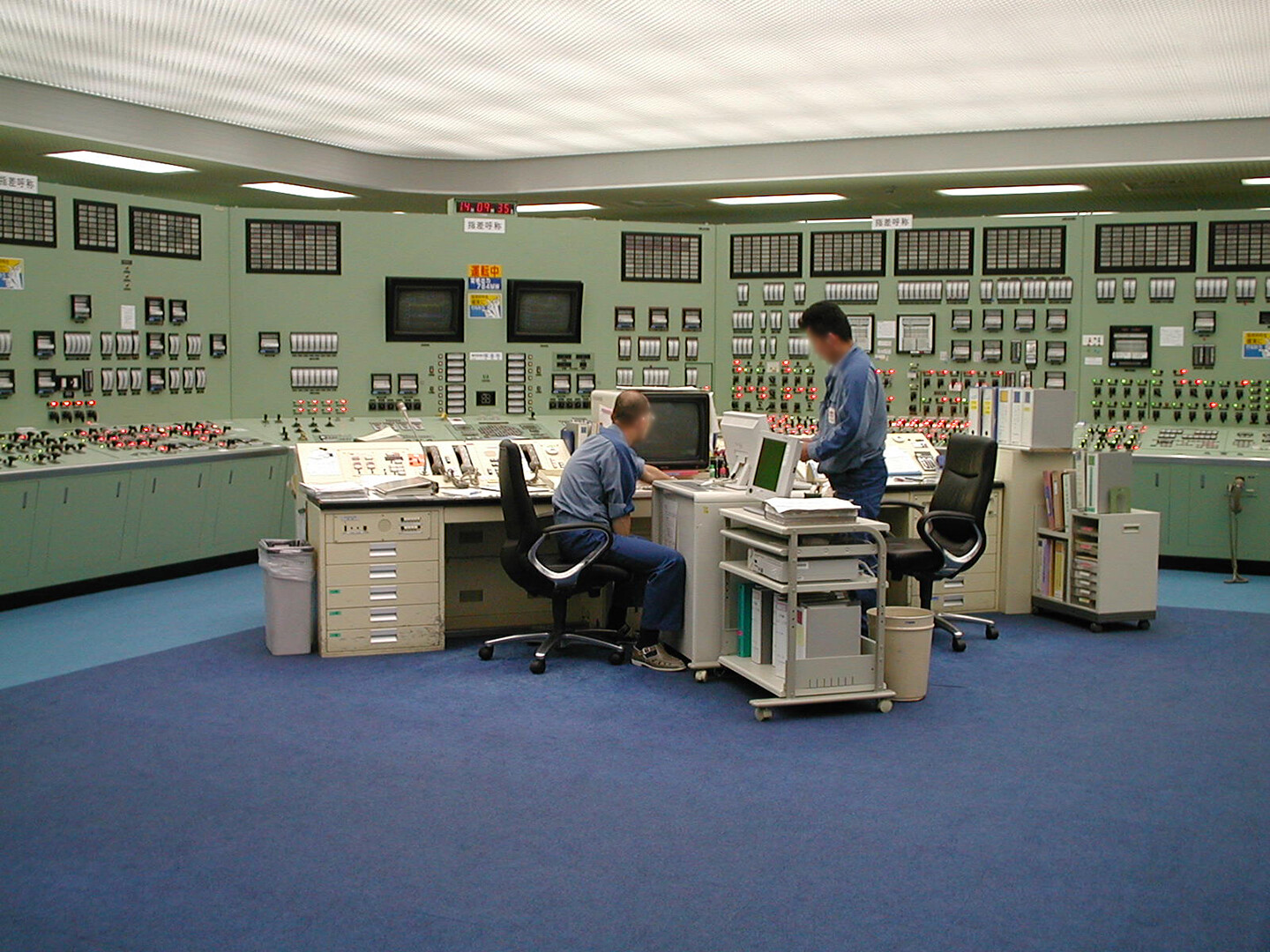On the very first page of Franco “Bifo” Berardi’s recent book The Third Unconscious, he writes, “The concepts that emerge in Sabu Kohso’s understanding of the Fukushima 2011 apocalypses are key for interpreting the global apocalypses of 2020: the ubiquitous, unstoppable proliferation of the principle of dissolution (radiation, viruses), the erosion of all symbolic and political orders, and the comeback of the long-denied Earth.”1 Bifo is referring to Radiation and Revolution, the first book in English by Japanese theorist, translator, and activist Sabu Kohso, published by Duke University Press. In the book, Kohso uses the Fukushima disaster and its aftermath to think the question of revolutionary decomposition in both Japan and the world. Kohso takes us through the formation of the insular and imperial Japanese nation-state project, its embeddedness within American empire, and its resulting history of nuclear devastation. Out of this wreckage of planetary ecological breakdown, Kohso says we are now newly able to imagine a revolution of terrestrial inhabitation, freed from the failure of historical materialism to imagine an apocalyptic communism, what he calls a “rediscovery of the Earth amidst the decomposition of the World.”2
I recently spoke with Kohso about Covid as a global Fukushima event, Tokyo and New York as sites of imperial disaster, and his political ontology of revolution and power.
—Matt Peterson
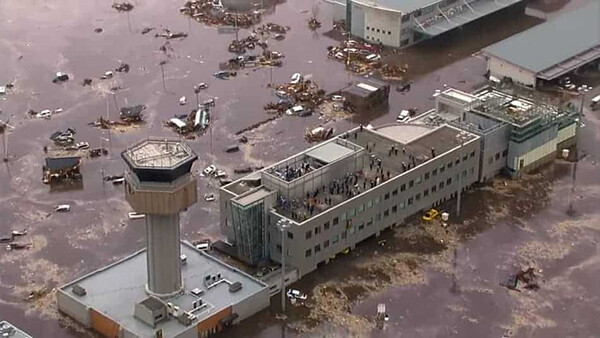

Fukushima nuclear plant after the tsunami hit.
Matt Peterson: Your book uses Fukushima as both a narrative device and conceptual framework to think through the last decade of struggles, offering a schema of disaster, catastrophe, and apocalypse. In many ways Covid serves this same function of revealing the disaster we’re living in. Almost instantly it was clear that Covid would come to delimit a global paradigmatic shift along the lines of 9/11, with an unmistakable before and after. How can you transpose your research to think about Covid as a worldwide version of this Fukushima experience?
Sabu Kohso: Yes, naturally, I compare the Fukushima experience with the Covid pandemic, because really both disasters are global, and they are in a sense both endless. The nuclear disaster has been eclipsed by the pandemic, but it’s not over. The Fukushima reactors are still releasing radionuclides into the planetary environment, so we are now living through a synergy of Fukushima and Covid, along with other ongoing disasters, and the mutations that accompany them.
We can think of this situation as a kind of chaos in which we are exposed to all these mixing and mutating planetary forces, and we cannot grasp the way our bodies are being thrown into this reality. If there’s one conclusion to draw from my experiences with Fukushima, it is that traditional politics cannot help us to deal with this situation. By that I mean the geopolitics of capitalist nation-states, based upon their territories, and on their ontology of “the World,” or the global totality that is the end limit of the capitalist state mode of development. Of course, we have no choice but to go on dealing with the geopolitical crises triggered by planetary phenomena such as radiation and coronavirus, climate change, the toxification of the environment, and so on—these crises will continue to determine the conditions for governance and profit-making on national and global scales. But what Fukushima has revealed is that we are also living in an age of climato-politics in which we must confront the chaos of planetary flows that trespass the borders of nation-states and evade their attempts at control.
The revelation of the Fukushima disaster was twofold. It revealed the powers that have made Japan and the World in this way, but it also revealed the powers of people’s lives-as-struggle on earth. For me, what was most inspiring in the post-Fukushima struggles were not just the huge protests or the direct actions, but also the way that so many autonomous initiatives appeared and flourished, especially in the first years after the disaster. Household reproductive workers were especially active. These were mostly women who self-organized to check water and food for radioactivity. There were local radiation monitoring centers established everywhere, and there was the movement of voluntary evacuees who left not only from Fukushima and the Tohoku region, but from Tokyo as well. Many were experimenting with different ways of living in different places, further from the center of the Tokyo metropolis and its hyper-consumerist forms of life.
If these post-Fukushima struggles have a message for us now amid the Covid pandemic, it is that we can and must confront these planetary flows, like radioactivity or coronavirus, in our own lives. This means that we must wage our struggles for survival not as national citizens or residents, but as planetary inhabitants. This shift ultimately entails an ontological dimension.
Despite the similarities between the Fukushima disaster and the Covid pandemic, the natures of radiation and the coronavirus are very different. In a way, they each show us what is essential in our lives and relations, by the dangers that they pose to them. Radiation is invisible, and it travels uncontrollably over great distances, along complex flows of planetary movements. The threat of radiation contamination is everywhere, and it destroys our trust in the land. It breaks the fundamental rapport of people with their living environments. On the other hand, Covid is this sometimes-deadly virus that spreads by person-to-person contact, so it threatens any and all social relations that involve corporeal, intra-human interactivity.
The disaster of the Covid pandemic reveals the crucial roles of mass corporeality: sensuality and physicality, assembly, mass events, and international movement and traveling. Its effects accentuate and intensify class and social divisions. The effects of the virus itself hit poor and marginalized populations harder, while the political measures to confine social activities and gatherings make them poorer. But at the same time, it was in the middle of this disaster that the 2020 uprisings took place. The peak of insurrection against the police corresponded to a peak in the pandemic. And an incredible series of riots, lootings, mass demonstrations, autonomous zones, and statue demolitions liberated us from the depression of confinement and social isolation, as it fed anti-colonial currents throughout the US and across the planet. As you and others have discussed, these uprisings went hand in hand with mutual aid projects, or with autonomous, community-based organizations, which had already been activated in response to the pandemic.
One idea that I’ve been thinking through lately, about the struggles of planetary inhabitants, is that they must involve at least three territories of practice, which can be designated by three principles of action: the first is protection of life, the second is militancy for confrontation, and the third is autonomy to connect the two. If there is some hope for the grim futures of disaster and crisis to come, it’s that in confronting apocalyptic situations, these three initiatives can especially flourish and enhance each other.
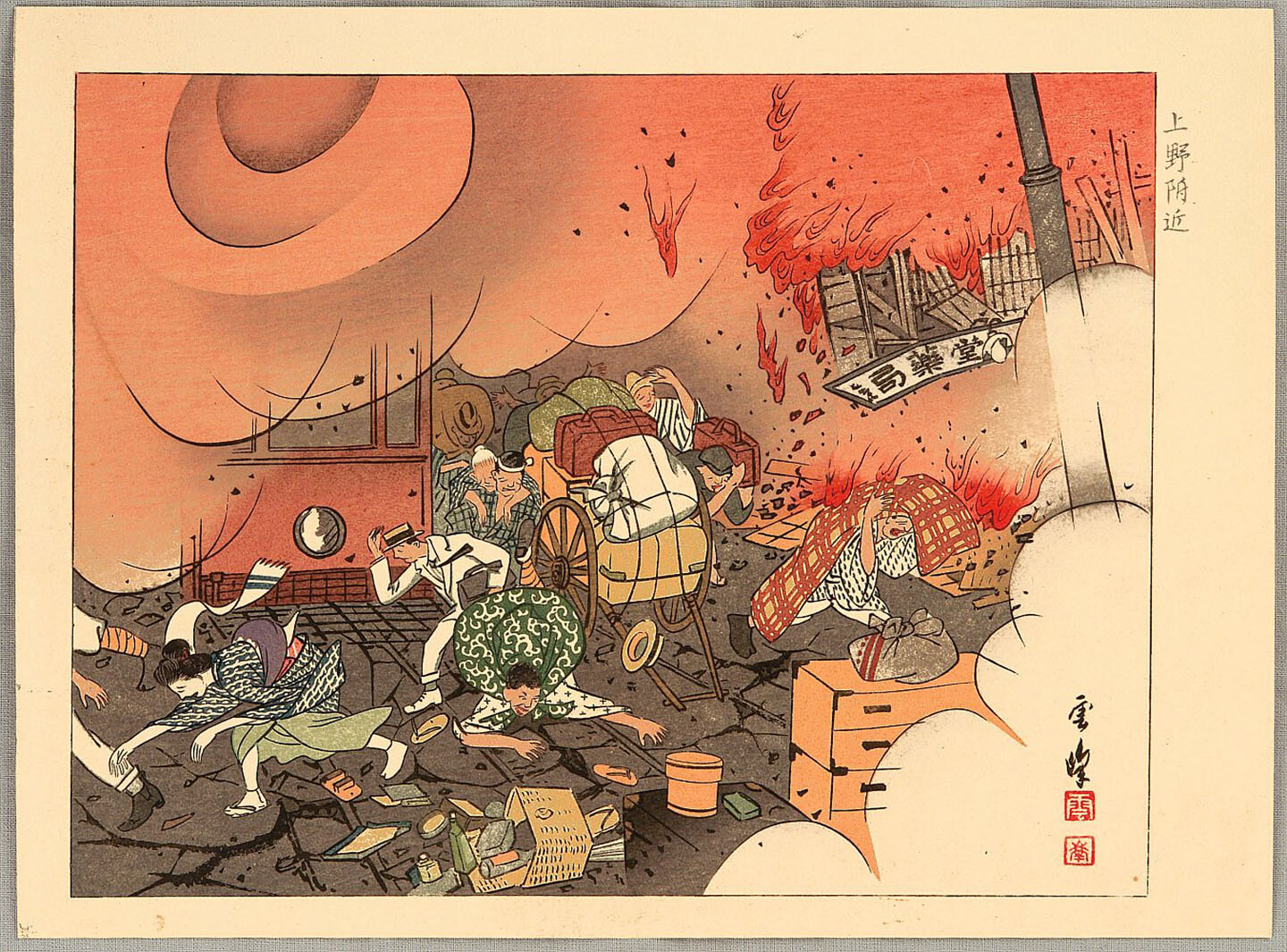

Unpo Takashima, Great Kanto Earthquake, ca. 1920s. Source: Unpo Takashima / Artelino.
MP: In your book you speak of Tokyo as a site of both disaster and empire, both of which were central to the project of Japan as a capitalist nation-state project, and your hope that the events of Fukushima would lead to Tokyo’s abandonment and decomposition. I know you’ve lived in New York for many years, which seems to serve much the same function for the American project. I’m curious how you think of the potential for lives-as-struggle within places like New York and Tokyo. How should we relate to the fight-or-flight dynamics in facing the catastrophe of the present?
SK: To say something about my hope for Tokyo’s decomposition, I should first say a little about Tokyo itself. The history of Tokyo is also a history of modern Japan, which is also a history of disaster. Inevitably there are the periodic earthquakes, which in the case of Fukushima became a nuclear disaster. In 1854 there was the Ansei earthquake, and in 1923 there was the Great Kanto earthquake. Tokyo’s infrastructure was also nearly completely destroyed by US firebombing in 1945. And on every occasion, Japan has used the catastrophe as a fulcrum to expand its power. Each time the city gets bigger, and the reconstruction of Tokyo provokes state expansion, and vice versa. In particular, the 1923 earthquake became a driver for Japanese imperialist expansionism. The earthquake sparked fires that engulfed Tokyo and Yokohama and killed 150,000 people. Many more lost their homes and livelihoods, and so there was a tremendous mobilization of immiserated people leaving the Kanto region in need of work, organized by state and corporate interests towards Manchuria and other places, to serve the expansion of the Japanese empire. So there’s a vivid collective memory of catastrophe triggering nationalism and fascism, along with totalitarian state operations and imperialist expansion. And Tokyo is always the main driver. This continues in a contemporary form with the post-Fukushima Olympics and the mega-developments of the Tokyo Bay, with their crazed utopian megalomaniac vision.
In a longer historical perspective, Tokyo is a relatively recent invention. Osaka, to the west, represents an older capital, and it embodies a more heterogeneous Asia. There’s a more visible presence of foreigners, Koreans, Chinese, Okinawans, and a more visible otherness in the culture there. But Tokyo is through and through the modern capital of Japan. This was signified symbolically with its name change from Edo to Tokyo, meaning “eastern capital,” with the 1868 Meiji Restoration, which marked the beginning of modernity in Japan. Since then, Tokyo has always been the leading power in the nationalist state capitalist project.
With Fukushima there was an opening when, for the first time, we could begin to imagine Tokyo’s end. The distance from Fukushima to Tokyo is not far, so Tokyo was well within the sphere of radioactive fallout. In the peak moments of the threat of apocalyptic disaster, many of my friends evacuated Tokyo—maybe 60 percent of them, and their perception of Tokyo was changed in a radical way. Before, they could have imagined that their lives would be in Tokyo forever, and then all of a sudden this ended. The permanence of Tokyo was shaken. Without knowing how it would play out, this rupture and opening inspired a hope for the abandonment of Tokyo, which could play a crucial role in the decomposition of Japan.
With this in mind, the tendency of “voluntary evacuation” after Fukushima becomes significant. It includes not just Fukushima and the surrounding Tohoku region, but also Tokyo, and other parts of the Kanto region, with many inhabitants fleeing to western Japan, or further north to Hokkaido. Even though the majority of evacuees eventually returned, Fukushima marked the beginning of a slower, longer exodus from Tokyo. Away from the consumerist metropolis, some evacuees have collectively embraced different forms of life, as they start farming, or hunting, or finding other techniques for surviving more self-sufficiently.
Meanwhile, among radical activists, there were serious conflicts between differing perceptions and practices regarding radiation, polarized geographically between “those who go north” and “those who go west.” Those who went north were the activists going to Fukushima to support disaster victims, and to attempt to organize nuclear workers. Those who went west were those dedicated to protecting themselves from radiation hazards, which included exodus and also community building. To many of us, it seemed that this latter tendency especially nurtured a potential for decomposing the post-nuclear disaster governance.
But then too, within that tendency there was a group that called themselves “zero-becquerelists,” who became extremely fanatical. They started criticizing not only those who went north, but also anyone who continued to live in an area where radioactive contamination could be traced, especially Tokyo. These arguments had a substantial impact in the activist milieu, at least in the first two or three years. But ultimately they became futile, and we stopped hearing anything from them at all. The futility of their arguments was also their arrogance. Most people had no choice but to live in the irradiated zones. Similarly, across the planet, most people have no choice but to live in extremely polluted environments, or in places facing increasing disaster by catastrophic climate change. These places are people’s homes, and the inevitable grounds of their lives in struggle.
In the complex realities we are facing, there’s a dimension of the event that we cannot control, we can only follow it, and the migration of people for survival is such an event. Also now, in Japan, there are two major declines taking place: depopulation and deurbanization, or de-Tokyo-ization, and I would like to affirm these politically. For one, the depopulation of Japan should be a chance for the nation to open its borders and to learn to cohabitate with heterogeneous others. As for de-Tokyo-ization, now it continues and expands not only in response to radiation, but to all the disasters that followed Fukushima: gentrification, recession, flood, and Covid. While life in cities is becoming harder, real estate values in the countryside are going down dramatically. This is a kind of reversal of the concentration of the metropolis that grounds the expansion of Tokyo/Japan; it is a dispersion from it.
The hopeful potential of deurbanization is not cut off from the potential for urban struggle. To share a personal story, I’m thinking of a group of close friends from Osaka who’ve been based in a day-laborers’ ghetto called Kamagasaki. In many ways, life-as-struggle there is harsh, and getting grimmer. But they’re always looking for ways to empower their collective struggles for survival. And so, a few months into the Covid pandemic, several of them moved to the nearby countryside. Now they are very busy, fixing up old houses, growing rice, hunting, learning about herbal medicines. They hope that their efforts can support struggles in Osaka. It is also very important for them to welcome friends from other places, to share in collective living there, and to make it a part of a global nexus of communes.
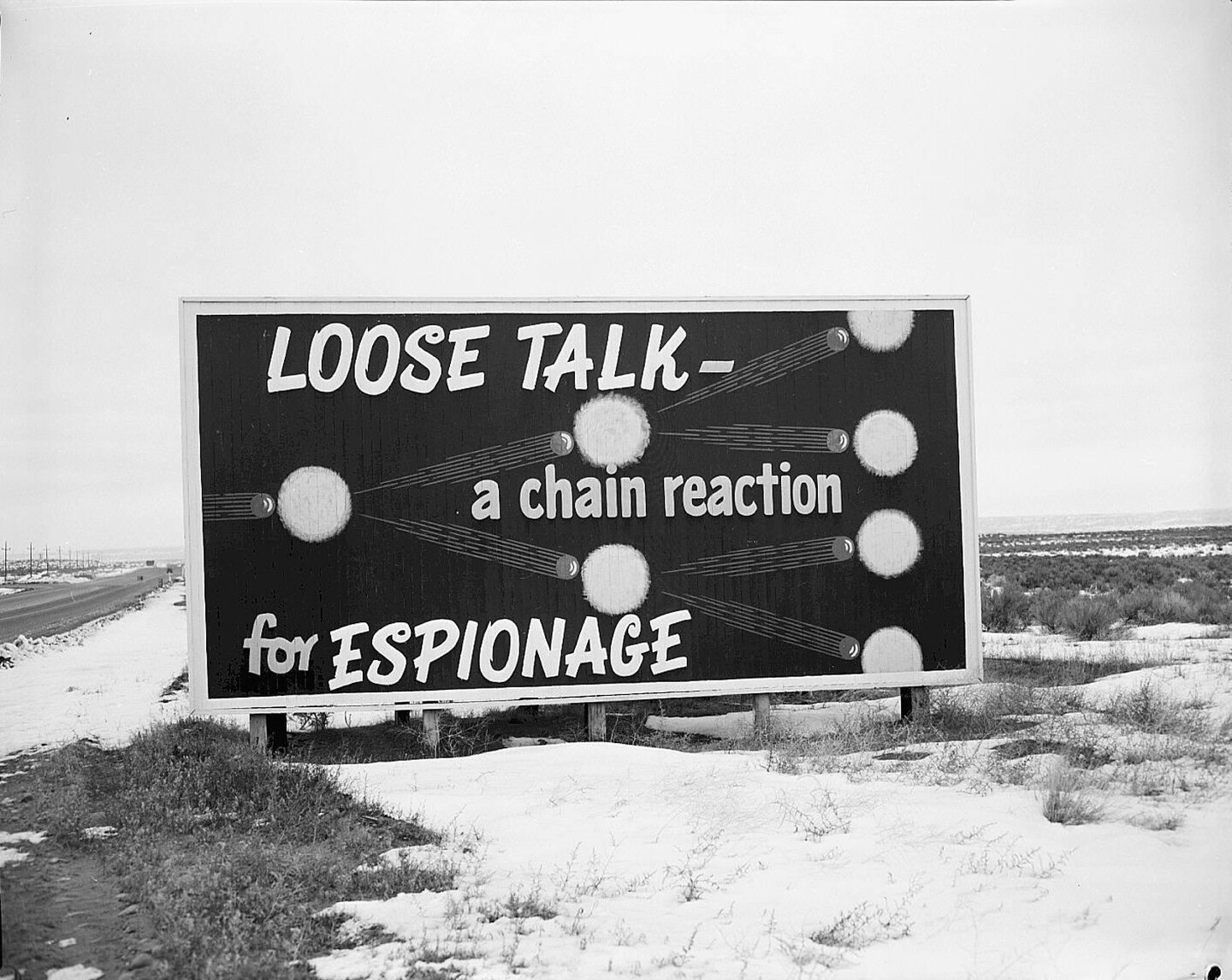

Cold War–era billboard at the Hanford site. License: Public domain.
MP: As a philosophy of revolution, your book is an important intervention, as it breaks from the dominant American or Western frameworks of democratic socialism and anti-fascism to talk of geo-philosophy, onto-politics, and a planetary becoming, where Deleuze and Guattari are seemingly your major references. How did you hope to challenge what and who we think of when we talk about revolution today?
SK: My thinking on revolution is based on my experiences of struggles since the early 1970s up until today. That includes not just broad, sociopolitical movements, but resistances in many different forms, which are always happening somewhere, somehow. And these form an impetus that continues, from the global ’68, through the so-called molecular revolutions of minoritarian resistances, to the local resistances to the violences of development, such as eviction and pollution, which in Japanese we call inhabitants’ movements. And then there was the global justice movement, inspired by resistances in the Global South and the uprisings around the 2008 financial meltdown, and then the Arab Spring, up until we reach the present of the post-Fukushima struggles, and now the pandemic-era insurrections against police.
People will never stop revolting. For various reasons, no matter the consequences, people will always rise up. And these uprisings with different characters, across different times and places, seem to energize each other in some dimension. Without command or political program, or international organization, there’s a planetary horizon where they reverberate. And I believe that it’s the experience of these reverberating uprisings which allows us to think of revolution, to conceive it as a project of completely changing the world. From their singular experiences in history, people elaborate new ideas of revolution.
But what does “changing the world” involve? The ideas of revolution seem to become more nuanced or multidimensional. There’s been an expansion of the existential dimension of “struggle” itself: it is not just sociopolitical, economic problems, it involves reproduction, the body, our living environments. And so the sites of struggle also multiply, in different dimensions: from city to periphery, production points to reproductive horizons, the spectacle to the invisible. This is what in Radiation and Revolution I have conceived as a shift in political ontology, moving from the horizon of national and international politics to the existential struggles of planetary inhabitants.
To be honest, sometimes I can’t help but compare the post-Fukushima struggles with the more militant struggles I experienced as a high school student in Tokyo in the late sixties and early seventies. Compared to the near-revolutionary situation of popular insurrection at that time, the post-Fukushima struggles are totally disappointing, and yet they give us a model of the sort of existential practices that may be necessary for our lives-as-struggle in worlds to come. If we view the militant struggles of the sixties and seventies as embodying the limits of national revolution, on the horizon of “the World,” then perhaps the post-Fukushima struggles indicate a political ontology of the future.
Philosophically speaking, the politics of the World involves totality, dialectics, and synthesis, while a politics of the earth would entail immanence and omnipresence. But this is not a clear-cut transition from A to B. I see it instead as an irreversible tendency, or as a tendency which has emerged irreversibly, and which may possibly be endless.
This is the dynamic that I wanted to interject into the debates on revolution, to look at forces and events from a planetary perspective, to show how they operate in a dimension beyond the World and its totalizing expansion, toward singularization and dispersion. For me this was an explicit challenge to historical materialism, with its thought grounded on an implicit or explicit totality. Although historical materialism has given us this elaborate system, which works for analyzing the World of the capitalist state mode of development, it is much less useful for approaching our struggles vis-a-vis the earth and planetary events. Instead, revolution becomes this idealistic projection involving the synthesis of humanity, or the unification of human and nature.
I do respect Marxism, and I love Marx’s writing, but as a revolutionary idea, it’s important to acknowledge its particular limits. With the First International, people really expected the proletariat of the world to unite, and we have to seriously consider why it didn’t happen, and why it’s still not happening through this internationalism. In any case I want to go along with this shift where historical materialists are losing their leading role in the thinking of revolution, and precisely what they cannot talk about is becoming more important.
Another aspect of this shift involves thorny problematics around power and violence. For thinking post-Fukushima, I was primarily interested in the ontological difference—which is an asymmetry—between the power of the state and capitalism as power-over, and the power of peoples’ lives and struggles as a power-to. For struggles that seek to change the world without taking power-over, they must find their strategic advantage within this asymmetry. Militaristically, of course, they are always inferior, but they are vastly superior in terms of their productive and reproductive powers, or their powers to create worlds. But between power-over and power-to there is a relationship of parasite and host. How can our lives-as-struggle change the worlds we inhabit without assimilating to the parasitic ruling powers, instead embracing the autonomy of the creative power of our own lives?
MP: When you speak of revolution you break from its twentieth-century imaginary, where even the New Left aspired to taking over the nation-state, and instead speak of an “anarchy in the apocalypse,” an “existential communism,” the “rediscovery of the Earth amidst the decomposition of the World.” You’ve used the phrases “life-as-struggle,” “living among the ruins,” the need to create “existential territories,” forgetting and relearning, “earthly singularities.” In an America still recovering from the Trump administration and Covid, with some of these frameworks in mind, what potential orientations could we look towards?
SK: I don’t know if this answers you philosophically, but speaking from my personal experience of Japan and the US, people tend to seek stability, but I cannot imagine that this could ever be attained, not even for the majority, especially not in America. And now, at this point in the ongoing disasters and crises, a return to stability or normality seems quite unlikely. But the alternative imaginaries are really quite scary.
As you know, I was born in Japan and came to the US in my early twenties. Since then, I’ve been going back and forth, so comparing these two countries has been my life, and often they seem like polar opposites. Japanese society is extremely homogeneous, relative to the US and other nation-states. It’s remarkably stable, and it really feels like what can happen in Japan is limited. Meanwhile American society is so heterogeneous, and America is this terrain of conflict where it seems that almost anything could happen, for better or worse. Looking at this difference in terms of geohistory, it makes sense. Since the end of WWII, Japan has arguably been America’s most faithful client state. The whole Japanese archipelago became a US base for its wars with its enemies on the Asian continent, especially the Korean and Vietnam wars. So when even America itself was in turmoil, Japan had to be stable and under control. Today, the Nansei Islands are increasingly militarized as a frontline against China.
America is an empire, yet the US government tries to govern its territories as if it were a nation-state, and to represent its unity to its populace as a nation of freedom. If anything, the American populace is the embodiment of America’s colonial histories, between Native peoples, slaves, colonizers, and immigrants from all over the planet. America internalizes the conflicts and crises of the World, and America’s governance over its fissured populace cannot be delinked from its wars and imperial expansion. To sustain its sovereignty, America goes on expanding as an empire. This is why the American populace is especially haunted. There’s an inherent paradox in the hope for America to create a free and peace-loving cosmopolitan society.
What orientation can people in America take at this moment, in this darkest present? I have no overarching vision, but a few possibilities seem clear. First, with all the political, economic, social, and environmental crises that will inevitably continue to immiserate people’s lives, local attempts to organize around mutual aid are going to become increasingly necessary. I think you all have been experiencing this already with Woodbine in New York City, and everywhere there are similar radical grassroots organizations that we can look to as models.
Another thing that seems clear is that we cannot assume a unity among different impetuses for change. Instead, we must assume that there are conflicts between diverging orientations. Personally speaking, I can never trust democratic socialism as a tendency, which tries to realize egalitarian reform for American society by taking state power. In my experience, its pattern is to first embrace all the various oppositional forces as it initially seeks to expand its influence, and then, when it achieves certain seats in governance, it immediately turns to oppress or exclude the most radical. At its core, it considers itself the only authentic major party, and it treats all others as a minority of left oppositions. Its “real politics” tends to actually conflict with revolutionary impetuses to decompose the American empire, which connect struggles both within and without the empire, among the planetary populace.
For me the planetary tendencies toward decomposition are the only plausible paths. It is difficult, and can be scary, to imagine where they lead, but I have to believe in that as a hope. Philosophically speaking, this is where the challenge of ontology appears, because it is a matter of people’s relations on and to the planet, which are themselves at stake. This is what I mean when I say “the rediscovery of the Earth amidst the decomposition of the World.” For lives-as-struggle across the planet, everything is at stake, within singular relations. These include relations between individuals and every sort of social relation, but also ecological and climatological relations, and cosmic and spiritual relations, which involve not only people but all kinds of planetary forces and beings. And in the decomposition of the World, these are all at stake.
Franco “Bifo” Berardi, The Third Unconscious: The Psychosphere in the Viral Age (Verso Books, 2021), vii.
Sabu Kohso, Radiation and Revolution (Duke University Press, 2020), 14.
